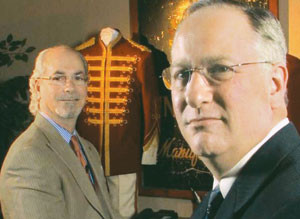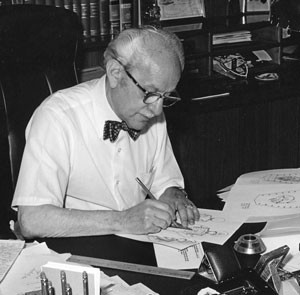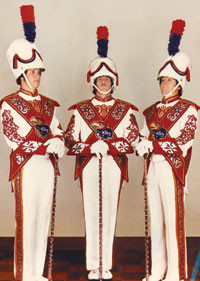From humble beginnings to becoming a cornerstone in the music and uniform industry, Fruhauf Uniforms boasts a rich history spanning over a century. Founded by Herman Fruhauf, an Austrian immigrant with a talent for tailoring, the company’s journey is a testament to quality, innovation, and enduring family values. This is the story of Fruhauf Uniforms, a brand synonymous with distinction and tradition in outfitting bands and organizations across the nation.
The Humble Beginnings in Wichita
Herman Fruhauf’s American dream began in the early 1900s when he arrived from Vienna, Austria, settling initially in New York. By 1907, Wichita, Kansas became his new home, where he utilized his tailoring skills as a window dresser and tailor at a local department store. Fate intervened one day when a gentleman entered the store seeking a suit fitting. During their conversation with the store owner, the man mentioned his need for uniforms for his newly formed town band. While the store owner declined to take on the task, Herman Fruhauf, with quiet confidence, declared he could craft the uniforms himself. This pivotal moment marked the unexpected inception of the Fruhauf family’s venture into the uniform business. Initially, orders were modest and primarily catered to nearby town bands. In 1910, Herman officially established his business as Fruhauf Southwest Uniforms, operating from a simple storeroom equipped with a few machines and a handful of operators. This part-time endeavor, serving a regional clientele, was destined to evolve into a full-fledged, nationwide enterprise, laying the foundation for the Fruhauf Uniforms we know today.
 Herman Fruhauf, founder of Fruhauf Uniforms, with a family member, showcasing the company's early tailoring roots and family heritage.
Herman Fruhauf, founder of Fruhauf Uniforms, with a family member, showcasing the company's early tailoring roots and family heritage.
Expanding Horizons: From Local Bands to National Recognition
As Fruhauf Southwest Uniforms grew, so did its reputation and reach. The company expanded beyond local bands, securing contracts with fraternal organizations, further diversifying its portfolio. During the World War II era, Fruhauf Uniforms played a crucial role in supporting the nation, manufacturing thousands of dress blue military uniforms for the government. Innovation became a hallmark of the company, exemplified by Herman’s son, Lou Fruhauf, who developed an ingenious orange flight suit specifically for military personnel involved in transporting servicemen between land and ships. The vibrant color was designed for high visibility, crucial for rescue operations in case of emergencies at sea. Over the years, Fruhauf Uniforms added prestigious clients to its roster, crafting uniforms for the esteemed Marine Band and the iconic Blue Angels flying team – including the flight suits worn by the pilots for ground interviews. They even provided uniforms for the President’s helicopter team, solidifying their status as a premier uniform manufacturer. Although the company produced its last military uniforms around 1968, its legacy of quality and innovation continued to flourish.
 Vintage workspace at Fruhauf Uniforms, illustrating the company's long history and evolution in uniform manufacturing.
Vintage workspace at Fruhauf Uniforms, illustrating the company's long history and evolution in uniform manufacturing.
Focusing on Music: The Evolution of Band Uniforms
Post-1968, Fruhauf Uniforms strategically shifted its primary focus to music uniforms, channeling its expertise into a market it had served since its inception. The company broadened its range to encompass attire for every facet of musical performance, from striking uniforms for drum majors to elegant concert attire. Recognizing the evolving needs of marching bands and drum corps, Fruhauf pioneered lightweight, washable uniforms in the late 1960s, a significant advancement for performers demanding comfort and practicality. When polyester fabrics gained popularity, Fruhauf Uniforms was at the forefront, instrumental in introducing lightweight flowing tops, known as corps blouses, revolutionizing the look and feel of marching band uniforms. Ken Fruhauf, the great-grandson of the founder and current company president, encapsulates the company’s enduring philosophy: “Our whole philosophy is that regardless of how a band acts or sounds on the field, the uniform has a sense of immediate respect and will impress viewers.” He recounts anecdotes from his father and grandfather about presenting uniform proposals at school board meetings in the 1950s and 1960s. In a competitive environment where multiple vendors had limited time to showcase their offerings, Fruhauf’s quality and value proposition stood out. A complete set – tux overlay, West Point uniform, and concert uniform – was priced at $65.95 for 16-ounce wool uniforms. Decisions were often swift; if the price met the board’s budget, orders were placed immediately, with measuring commencing the very next day. Quality assurance was paramount, albeit unconventional. School board members might test uniform samples with a rudimentary strength test – pulling on a sleeve. Durability determined the order, highlighting the emphasis on robust construction and lasting quality that Fruhauf Uniforms has always been known for.
Modern Uniforms: Embracing Change and Innovation
Today’s band uniforms reflect a departure from strictly militaristic aesthetics, embracing modern design elements while retaining a sense of formality and impact. Contemporary Fruhauf uniforms often feature bold blocks of color and flowing sections, offering a dynamic visual appeal. The once prevalent rigid West Point style has become less common, replaced by form-fitted and lighter weight garments that accommodate the increased athleticism of modern performances. Field choreography has evolved to incorporate more dance and intricate movements compared to the traditional high marching step. Dance lines and color guards have become integral to shows, necessitating uniforms that are not only visually stunning but also comfortable and easy to move in. Modern designs often incorporate fewer buttons and braid, with detail achieved through strategic color blocking. Gauntlets and expressive hand movements are more prominent, and plumes have grown taller, enhancing the visual height and presence of performers on the field.
 Modern Fruhauf marching band uniforms with vibrant colors and flowing designs, reflecting contemporary trends in performance attire.
Modern Fruhauf marching band uniforms with vibrant colors and flowing designs, reflecting contemporary trends in performance attire.
A Century of Survival and Success
Fruhauf Uniforms has not only endured but thrived for over a century, witnessing the decline of other major uniform manufacturers such as Ostwald, Sol Frank, and Fechheimer. Employing up to 165 individuals, the company experiences peak activity from March through October, yet remains agile enough to handle even last-minute, demanding requests. The company’s responsiveness was notably demonstrated when the marching band director at Northwestern University contacted Fruhauf in mid-October 1995. The university president had unexpectedly requested new uniforms for the band’s Rose Bowl appearance. Ken Fruhauf personally flew to Chicago, measured the entire band, and secured the purchase order within a week. Promising delivery in under seven weeks, Ken Fruhauf leveraged industry relationships to ensure timely material sourcing, even relying on competitors for expedited fabric and braid supplies. He successfully delivered the uniforms, highlighting the collaborative spirit within the uniform industry. “We have a wonderful relationship with our competitors: if one of us cannot get supplies in time to fulfill a contract, others will share from their excess inventory. We have had this good working relationship with other uniform makers for 70 or 80 years and this says a great deal about the uniform business.” This anecdote underscores not only Fruhauf Uniforms’ commitment to customer satisfaction but also the remarkable camaraderie within the uniform manufacturing sector. As Fruhauf Uniforms steps into its next century, it carries forward a legacy of innovation, quality, and a deep-rooted commitment to serving the music community, continuing to impress and inspire with every uniform created.
